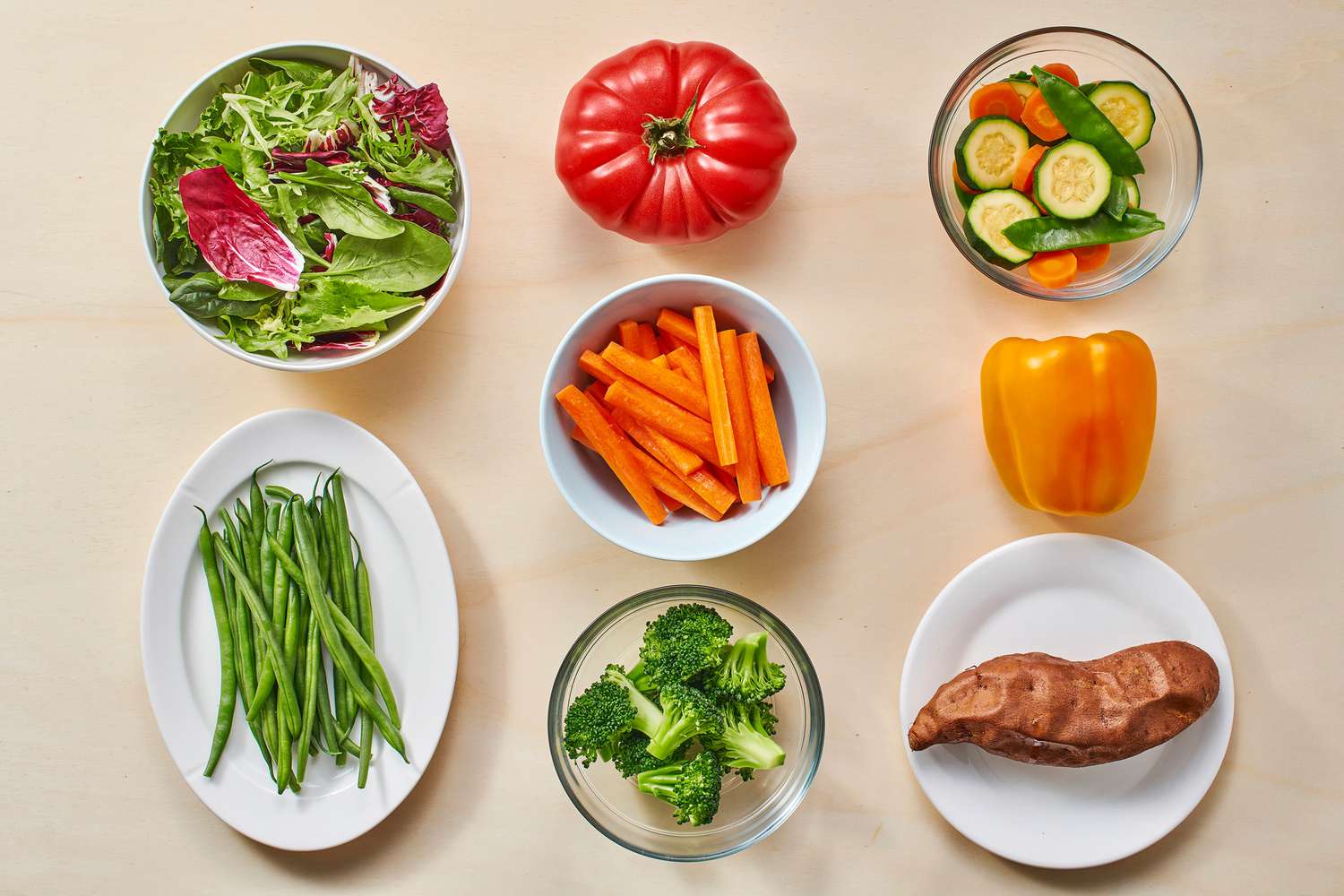Home>Gardening News and Trends>Latest News>How Much Is 1 Serving Of Vegetables


Latest News
How Much Is 1 Serving Of Vegetables
Modified: January 22, 2024
Discover the latest news on how much is considered one serving of vegetables and the importance of including them in your daily diet.
(Many of the links in this article redirect to a specific reviewed product. Your purchase of these products through affiliate links helps to generate commission for Chicagolandgardening.com, at no extra cost. Learn more)
Table of Contents
Introduction
When it comes to maintaining a healthy diet, one of the key components is ensuring an adequate intake of vegetables. They are packed with essential vitamins, minerals, and fiber that can support overall well-being and contribute to disease prevention. However, there is often confusion about what constitutes a proper serving size of vegetables. Understanding the recommended serving sizes for different vegetables is crucial for achieving the right balance in your daily meals.
Healthy eating guidelines emphasize the importance of consuming a variety of fruits and vegetables daily. The United States Department of Agriculture (USDA) recommends that adults consume 2 to 3 cups of vegetables per day, depending on age, sex, and level of physical activity. These guidelines serve as a general rule of thumb that can help individuals meet their nutritional needs and maintain a balanced diet.
While the recommended serving sizes may seem straightforward, it is essential to understand what they actually entail. Serving sizes can vary depending on the specific vegetable being consumed. For example, one serving size of leafy greens like spinach or kale is typically measured in cups, while other vegetables, such as carrots or broccoli, are measured by weight or count.
To determine the appropriate serving size of vegetables, it is helpful to be familiar with common measurements and visual references. By knowing how much constitutes one serving, you can ensure that you are consuming an adequate amount of vegetables to meet your nutritional goals.
In this article, we will explore the different measurements used to determine one serving of vegetables and provide examples of common vegetables and their serving sizes. Additionally, we will discuss the benefits of including the recommended vegetable servings in your diet and provide tips for incorporating more vegetables into your meals.
Serving Size and Recommendations
When it comes to maintaining a healthy diet, understanding serving sizes and following recommended guidelines is crucial. Serving sizes act as a reference point for the amount of food you should consume to meet your nutritional needs. For vegetables, the recommended servings are based on the quantity that provides a range of beneficial nutrients.
The United States Department of Agriculture (USDA) provides general recommendations for vegetable servings, which can vary depending on age, sex, and level of physical activity. As a general guideline, most adults should aim to consume 2 to 3 cups of vegetables per day. However, these recommendations are not one-size-fits-all, and it’s important to consider individual needs and dietary preferences when determining serving sizes.
When planning your meals, it’s important to be mindful of the different forms that vegetables can take. Some vegetables are commonly consumed raw, while others are cooked or used in dishes like soups, stews, or stir-fries. The cooking process can affect the volume and weight of the vegetables, which may impact the serving sizes.
Additionally, the recommendation for vegetable servings does not mean you have to consume all of them in one sitting. You can spread out your vegetable intake throughout the day by including them in snacks, salads, side dishes, or incorporated into main courses. The key is to ensure that you are meeting the recommended daily intake.
While the recommended servings provide a general guideline, it’s essential to personalize your vegetable intake based on your individual needs and preferences. If you have specific dietary restrictions or health conditions, consulting a healthcare professional or registered dietitian can help you determine the appropriate serving sizes and types of vegetables that best suit your needs.
Remember, these recommendations are meant to serve as a starting point and may need to be adjusted based on your unique circumstances. It is always important to listen to your body and make adjustments accordingly.
Understanding Serving Sizes
Understanding serving sizes is essential for effectively incorporating the right amount of vegetables into your diet. While the general recommendation for the number of vegetable servings is useful, it’s equally important to grasp the specific measurements associated with serving sizes.
Serving sizes for vegetables can vary based on the specific vegetable and its form (raw, cooked, or processed). Here are some key measurements and visual references that can help you understand serving sizes:
- Cups: Leafy greens like spinach, lettuce, or kale are often measured in cups. One cup of raw leafy greens is equivalent to a serving size. You can visualize one cup as roughly the size of a baseball or a closed fist.
- Weighing: Some vegetables, such as tomatoes or peppers, may be weighed to determine the serving size. One serving of these vegetables usually amounts to around 100-150 grams, which is often indicated on food labels or can be measured using a kitchen scale.
- Pieces or Count: Certain vegetables, like carrots or broccoli, can be measured by the number of pieces. For example, one serving of carrots is typically three medium-sized carrots or one cup of sliced carrots.
- Canned or Processed: When using canned or processed vegetables, it’s important to refer to the nutritional label for serving sizes. These may vary based on the type of preparation (e.g., whole, sliced) and the packaging.
It’s important to note that individual portion sizes may vary based on personal preference and dietary needs. If you prefer larger or smaller quantities of certain vegetables, you can adjust the serving sizes accordingly. The goal is to consume an adequate amount of vegetables to meet your nutritional requirements.
Understanding serving sizes can also help you make better decisions when dining out or consuming processed foods. By being aware of the typical serving sizes, you can gauge whether the portions offered align with your desired intake of vegetables and make informed choices.
While serving sizes help guide your vegetable intake, it’s important to remember that variety is equally crucial. Aim to consume different types and colors of vegetables to benefit from a wide range of nutrients. Experiment with different cooking methods, flavors, and recipes to make your vegetable-centric meals even more enjoyable.
Determining 1 Serving of Vegetables
Determining the exact serving size of vegetables can sometimes be challenging, especially when different vegetables require different measurements. To make it easier, here are some general guidelines to help you determine what constitutes one serving of vegetables:
- Leafy Greens: One serving of leafy greens, such as spinach, lettuce, or kale, usually amounts to one cup of raw leaves. This can be equivalent to a small handful or roughly the size of a baseball.
- Cruciferous Vegetables: Vegetables like broccoli or cauliflower can be measured in a similar way to leafy greens. One serving generally amounts to about one cup of raw florets, or around six to eight medium-sized florets.
- Root Vegetables: For root vegetables, such as carrots, potatoes, or beets, serving sizes can vary based on the specific vegetable. As a general rule of thumb, one serving is often equivalent to one medium-sized vegetable or about one cup of sliced or diced pieces.
- Beans and Peas: Beans and peas, which are considered both vegetables and legumes, can be measured by the cup. One serving is often around ½ to ¾ cup of cooked beans, lentils, or peas.
- Tomatoes: One medium-sized tomato or a cup of cherry tomatoes typically constitutes one serving of tomatoes.
- Corn: A half-cup of cooked corn kernels is generally considered one serving of corn.
- Bell Peppers: One medium-sized bell pepper, regardless of color, is usually equivalent to one serving.
Keep in mind that these serving sizes are general guidelines and can vary depending on individual preferences and dietary needs. Adjust the serving sizes based on your specific goals and nutritional requirements. If you are following a specific diet plan or have dietary restrictions, consult with a healthcare professional or registered dietitian to determine the appropriate serving sizes for your needs.
When incorporating vegetables into your meals, it’s beneficial to be familiar with the serving sizes. This knowledge enables you to ensure that you are consuming an adequate amount of vegetables to meet your nutritional goals. Additionally, being aware of serving sizes allows you to plan and prepare your meals accordingly, helping you maintain a well-balanced diet.
Common Vegetables and Their Serving Sizes
Knowing the serving sizes of common vegetables can help you plan your meals and ensure you are consuming the recommended amounts. Here are some examples of popular vegetables and their typical serving sizes:
- Carrots: One medium-sized carrot or around ½ cup of sliced or diced carrots is considered one serving.
- Broccoli: One cup of raw broccoli florets or around six to eight medium-sized florets is equivalent to a serving.
- Cauliflower: Similar to broccoli, one cup of raw cauliflower florets constitutes one serving.
- Spinach: One serving of raw spinach measures about one cup of loosely packed leaves.
- Kale: Similar to spinach, one serving of raw kale is around one cup of loosely packed leaves.
- Bell Peppers: One medium-sized bell pepper, regardless of color, is typically considered one serving.
- Zucchini: One medium-sized zucchini or around ½ cup of sliced zucchini is often considered a serving.
- Cucumbers: One medium-sized cucumber or around ¾ cup of sliced cucumbers constitutes a serving.
- Tomatoes: A medium-sized tomato or a cup of cherry tomatoes is usually considered one serving.
- Sweet Potatoes: One medium-sized sweet potato or about ½ cup of mashed sweet potatoes is typically considered a serving.
These serving sizes are approximate measurements and can serve as a starting point. Keep in mind that individual preferences and dietary needs may vary, so feel free to adjust the serving sizes to suit your specific goals and requirements.
When it comes to cooked or processed vegetables, such as canned or frozen options, be sure to refer to the nutritional labels for serving sizes. These may vary depending on the preparation and packaging.
Remember, the key is to consume a variety of vegetables to benefit from the wide range of nutrients they offer. Incorporating different types of vegetables into your meals not only adds flavor and variety but also provides a diverse array of vitamins, minerals, and antioxidants.
By being aware of the serving sizes, you can ensure that you are getting the right amounts of vegetables in your diet and supporting your overall health and well-being.
Benefits of Eating Recommended Vegetable Servings
Eating the recommended servings of vegetables can have numerous benefits for your health and well-being. Here are some key advantages of incorporating the recommended vegetable servings into your diet:
- Nutrient-Rich: Vegetables are packed with essential vitamins, minerals, and dietary fiber that contribute to overall health. They provide a wide range of nutrients, including vitamins A, C, and K, folate, potassium, and antioxidants. Consuming the recommended servings ensures you are getting a diverse array of these important nutrients.
- Improved Digestion: The fiber content in vegetables aids in digestion and helps prevent constipation. It promotes healthy bowel movements and supports a healthy gut microbiome, which plays a crucial role in overall digestive health.
- Weight Management: Vegetables are low in calories and high in fiber, making them a great addition to a weight management plan. They can help you feel full and satisfied without adding excess calories, making it easier to maintain a healthy weight or even promote weight loss.
- Heart Health: A vegetable-rich diet is associated with a lower risk of cardiovascular diseases. Many vegetables, such as leafy greens, are rich in antioxidants and compounds that support heart health, such as beta-carotene, lutein, and potassium.
- Cancer Prevention: Some vegetables, particularly cruciferous vegetables like broccoli and cauliflower, contain compounds that have been linked to a lower risk of certain types of cancer. The high fiber content of vegetables also promotes a healthy digestive system, which can help reduce the risk of colorectal cancer.
- Improved Blood Sugar Control: The fiber and complex carbohydrates in vegetables can help regulate blood sugar levels, making them beneficial for individuals with diabetes or those at risk of developing diabetes. Including a variety of non-starchy vegetables in your diet can support better blood sugar control.
- Enhanced Immune Function: Vegetables are rich in vitamins, minerals, and antioxidants that support a healthy immune system. Consuming the recommended servings helps provide your body with the nutrients it needs to fight off infections and maintain optimal immune function.
These are just a few examples of the many benefits you can enjoy by including the recommended servings of vegetables in your diet. Remember, the key is to consume a variety of vegetables to benefit from their unique blend of nutrients and health-promoting compounds.
By making vegetables a central part of your meals, you’re not only nourishing your body but also enjoying a wide range of flavors, textures, and culinary possibilities. Experiment with different cooking methods, try new vegetables, and explore exciting recipes to make your vegetable-centric meals truly enjoyable.
Tips for Incorporating More Vegetables into Your Diet
Incorporating more vegetables into your diet doesn’t have to be a challenging or boring task. Here are some practical tips to help you increase your vegetable intake and make it enjoyable:
- 1. Plan Ahead: Take some time to plan your meals and snacks in advance. Include vegetables in your meal preparation by cutting up fresh produce, roasting vegetables, or preparing salads to have on hand for quick and convenient options.
- 2. Mix and Match: Get creative and combine different vegetables to add variety to your meals. Mix different colors, textures, and flavors to make your dishes visually appealing and satisfying.
- 3. Sneak Them In: If you or your family members are picky eaters, find ways to sneak vegetables into your meals. Blend vegetables into sauces, soups, or smoothies, or incorporate them into dishes like casseroles, stir-fries, or omelettes.
- 4. Experiment with Cooking Methods: Explore different cooking methods to find ones that bring out the best flavors in vegetables. Roasting, steaming, grilling, or sautéing can add depth and enhance the natural sweetness of vegetables.
- 5. Add to Your Favorites: Identify your favorite dishes or meals and find ways to incorporate vegetables into them. Whether it’s adding spinach to your omelette, topping your pizza with colorful veggies, or layering vegetables into your sandwiches, find creative ways to include them in the foods you already love.
- 6. Make Salads Exciting: Jazz up your salads by adding a variety of vegetables, fruits, nuts, seeds, and even a sprinkling of herbs or cheese. Experiment with different dressings to keep your salads interesting and flavorful.
- 7. Veggie Snacks: Keep a selection of fresh-cut vegetables like carrots, celery, and bell peppers in the fridge for easy snacking. Pair them with healthy dips like hummus or guacamole for added flavor.
- 8. Grow Your Own: Consider starting a small garden to grow your own vegetables. This not only provides you with convenient access to fresh produce but can also be a rewarding and enjoyable experience.
- 9. Be Mindful of Portions: Be mindful of the portion sizes of vegetables to ensure you’re getting the recommended servings. Use measuring cups or kitchen scales to accurately portion your vegetables, especially if you’re working towards specific dietary goals.
- 10. Explore Ethnic Cuisines: Look into ethnic cuisines that heavily feature vegetables, such as Mediterranean, Asian, or Middle Eastern. These cuisines often offer a wide range of vegetable-based dishes that can add variety and excitement to your meals.
Remember, small changes over time can lead to significant improvements in your vegetable intake. Aim to gradually increase the number of servings you consume each day and experiment with new vegetables and recipes. Enjoy the journey of discovering new flavors and reaping the benefits of a vegetable-rich diet.
Conclusion
Incorporating the recommended servings of vegetables into your diet is an essential component of maintaining a healthy and balanced lifestyle. Vegetables are rich in vitamins, minerals, and fiber, providing numerous health benefits, including improved digestion, weight management, heart health, and a reduced risk of chronic diseases.
Understanding serving sizes and familiarizing yourself with the recommended portions of common vegetables can help you make informed choices and ensure you are getting the right amounts of nutrients. Remember that the recommended vegetable servings may vary based on individual needs, and consulting with a healthcare professional or registered dietitian can provide personalized guidance.
By following simple tips like planning ahead, experimenting with cooking methods, and incorporating vegetables into your favorite dishes, you can make eating vegetables enjoyable and sustainable. Embrace the diverse flavors and textures of vegetables, and make them a central part of your meals and snacks.
Whether you’re adding spinach to your morning smoothie, roasting a medley of colorful vegetables for dinner, or enjoying a crisp salad, every small step toward incorporating more vegetables into your diet can have a positive impact on your overall health and well-being.
So, start today by taking a step towards a vegetable-rich lifestyle. Your body will thank you for it!










